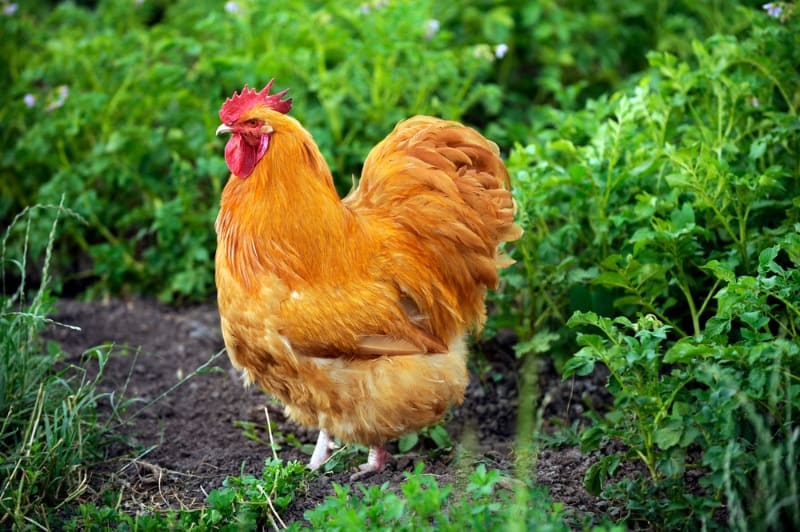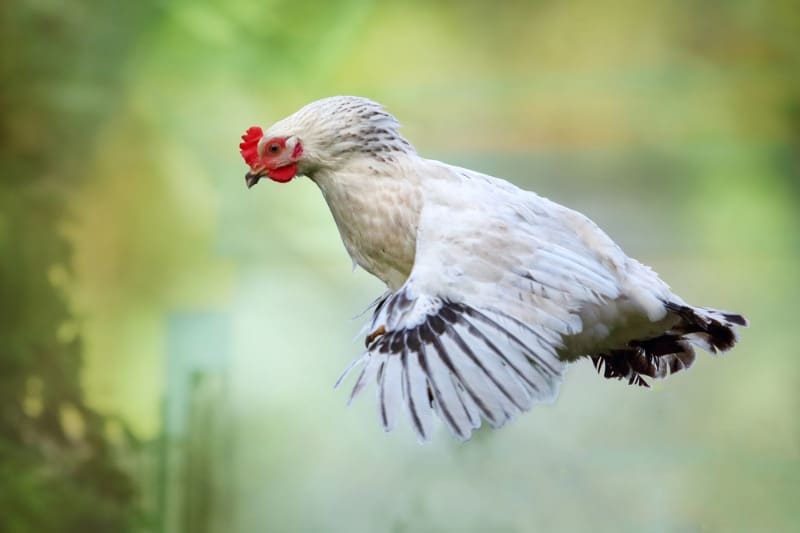The backyard chickens many people keep are distant relatives of the junglefowl still found in parts of Asia. In the wild, junglefowl behave like most other birds by perching and roosting in trees. And just like other birds, they’re able to fly to escape predators. When a wild junglefowl is foraging for food on the ground, they will quickly take flight if alarmed.
While that’s all well and good, what about domestic chickens we keep in our backyards? Can they fly? The answer is yes, many backyard chickens can fly, but not very high or far. There are many chicken breeds that can fly and there are some that can’t fly that well. Just don’t expect to see a pet chicken flying high in the sky like a crow or eagle.

Which Domestic Chickens Can Fly?
The ability of a chicken to take flight is typically determined by the breed type. Heavy breeds like Wyandottes may be able to fly, but they only get a few inches off the ground and don’t get very far. This breed’s wings simply aren’t built to give the chickens the lifting power they need for the size of their body.
- Anconas
- Leghorns
- Araucanas
- Red Rangers
- Spitzhaubens
- Bantams

Breeds that don’t fly very well include Silkies, Orpingtons, Plymouth Rocks, and Australorps. The feathers of Silkie chickens are like the fluffy down on chicks, which aren’t conducive to flying.
Breeds like the Orpingtons and Plymouth Rocks are simply too heavy to fly, at least very far. While a heavy chicken may lift up and off the ground using their wings, they never truly take flight due to the bird’s weight.

Why Many Chickens Aren’t Good Flyers
Many chickens are not good flyers because they were domesticated for their meat and eggs, and consequently, future generations of selective breedings have not tried to preserve their ability to fly well—a trait wild jungle fowl still possess. For example, broilers are designed to pack on weight quickly, and therefore, they simply lack the strength to fly because their bodies are far too heavy. Likewise, layers are bred for laying potential, not flying ability.
Many chickens escape from predators by flapping their wings and lifting themselves off the ground while using their feet to get away. They’ll often jump up on a perch or something else off the ground to get themselves out of harm’s way.
Take Wing — Bantams
Bantams are among the best flyers of all the different breeds of domestic chickens. These small and lightweight chickens can easily fly over the tops of fences so you must make sure to secure them well if you plan on having a flock.

What Prompts a Chicken to Fly?
- Predators – A chicken will flap their wings and fly away when they feel
- Curiosity – Chickens are naturally curious and like to investigate new things.
- Mating – A rooster going after a hen may prompt her to fly.
- Avoidance – Many chickens will fly away to avoid conflicts and fights.
- Confrontation – When they fight with their conspecifics, chickens will fly a little to jump higher up before they land a kick or peck on their opponent.
Chickens Can Fly Several Feet High in the Air
Many backyard chickens can fly 4 to 6 feet in the air if they’re determined enough. This means if you plan on putting a fence around your chicken coop, make it a tall one that’s at least 5 feet tall.
It’s important to know that if chickens are given a large, fenced area, they’re less inclined to fly over the fence to escape. When your chickens feel secure in their fenced area, they’ll likely stay put and feel right at home. If you keep small breeds or breeds prone to flying, add a bit of height to your fence or clip the chicken’s wings as an additional precaution.
Chickens with properly clipped wings cannot typically fly higher than 2 to 3 feet off the ground. Some people clip the primary flight feathers on one wing only and find that’s enough. Others opt to clip both wings, which ensures that a chicken stays grounded. A chicken with both wings clipped will quickly learn that they cannot take flight and will adjust accordingly.
How to Clip a Chicken’s Wings
Clipping a chicken’s wings is easy as all you need is a pair of scissors and a steady hand. Simply get a good grasp of the bird and stretch the wing out so you can see the primary flight feathers (the largest feathers that form the tip of the wing).
Cut along the top of the secondary feathers you can see about halfway over the primary feathers. You only need to clip away a few inches of the primary feathers and you’re done. And don’t worry that you’ll hurt the chicken because it won’t feel anything other than a little stress from being handled.
Important: Carefully inspect each feather before cutting it. An immature feather with a dark blue hue along the center, known as a blood feather, should not be cut. As the name suggests, this feather will bleed profusely if cut. If you’re unsure about clipping your chicken’s wings, consult your veterinarian.

Conclusion
Contrary to what many people believe, some chickens can fly and escape. How high your chickens can fly depends on the breed you keep. Most pet chickens can reach a height of around 6 feet when in flight. If you don’t want your chickens flying away, either put in a tall fence or clip their wings to keep them safely grounded.
Featured Image Credit: TTstudio, Shutterstock
